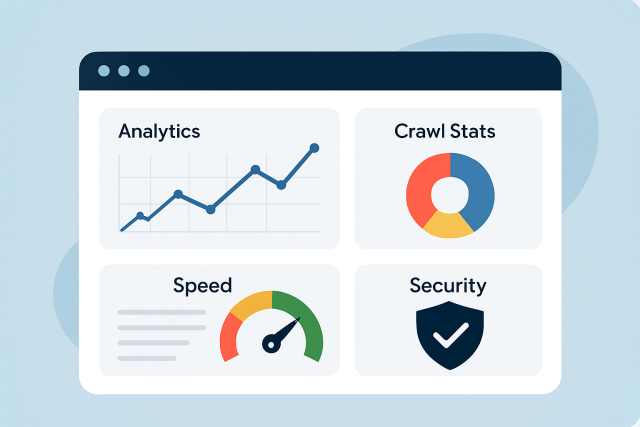Screaming Frog SEO Spider Tool for Website Audits


Technical SEO audits can feel like trying to find a needle in a haystack. Thankfully, the Screaming Frog SEO Spider tool breaks things down with clear and straightforward insights into a website's health and performance.
What exactly does Screaming Frog SEO Spider get up to
Screaming Frog SEO Spider is a pretty powerful website crawling tool that dives into your site to pick up all the vital SEO details.
- Scans websites to gather detailed data on URLs and site structure so nothing important slips through the cracks
- Spots broken links and server errors that could sabotage your SEO efforts
- Reviews meta titles, descriptions and header tags to give your optimization extra polish
- Creates XML sitemaps to help search engines find and index your content—think of it as a well-marked map for the web
- Connects with Google Analytics and Search Console to bring valuable insights that help you stay ahead
Why Should You Pick Screaming Frog for Website Audits?
Technical SEO audits are a vital step in uncovering those sneaky on-site issues that might quietly chip away at your organic traffic or tank your rankings.
- Spots broken and dead links that can seriously tank the user experience
- Detects duplicate content that has search engines scratching their heads
- Flags missing or off-the-mark meta titles and descriptions that need some TLC
- Points out slow-loading pages that might be scaring visitors away and hurting SEO
- Identifies redirect chains that make crawlers take the scenic route unnecessarily
- Highlights pages with thin or low-quality content that could use a bit more substance
Screaming Frog Crawling Process
Think of Screaming Frog as a meticulous spider weaving its way through your website, poking around every nook and cranny. It follows links just like a curious person clicking through, pulling pages and collecting SEO data.
Kick things off by popping the website URL you want to audit into the tool.
It starts crawling the homepage and then hops along to the links it finds.
Along the way it collects all the SEO goodies like URLs, status codes and metadata.
All this info gets bundled into detailed and easy-to-sort reports that won’t make your head spin.
Finally you dive into these reports to pinpoint any hiccups and figure out the best ways to boost your site.
A Closer Look at the Key Features That Make Screaming Frog Tick
Screaming Frog packs a bunch of handy features aimed squarely at sniffing out and breaking down SEO problems. Each tool zeroes in on a key piece of site health that’s important to both search engines and real people.
- Broken link checker spots those pesky URLs that just won’t load and can irk users and tank their experience
- Meta data analysis picks up on missing or repeated titles and descriptions to help you tidy up the basics that often get overlooked
- Shows HTTP response codes so you can get a clearer picture of server status and sneaky errors lurking beneath the surface
- Crafts XML sitemaps designed to boost your chances of getting nicely indexed by search engines
- Tracks down canonical URLs to keep duplicate content headaches at bay
- Checks out page depth to see how your pages are stacked in the crawling queue and which ones get the spotlight
- Hooks up with Google Analytics to deliver richer insights about who’s visiting and what they’re really up to
Handy Tool for Tracking Down Those Pesky Broken Links
Broken links send users down a frustrating rabbit hole—landing on pages that just don’t exist or refuse to load. This not only takes a toll on the user experience but also puts a dent in your search rankings. Screaming Frog swoops in to check every single link on your site, then hands you a neat list of all the broken URLs along with their sources.
A Closer Look at Meta Data
Meta titles, descriptions and header tags give search engines a straightforward snapshot of what your page is about. Screaming Frog cleverly flags any missing or duplicate meta data so you can fine-tune your site's relevance.
Understanding Response Codes and Redirects with a Quick Guide and Insight
HTTP status codes like 200 (OK), 301 (permanent redirect) or 404 (not found) show how your pages respond to requests. Screaming Frog scans your entire site to find these codes and detects redirect chains or loops that can drain your crawl budget and slow down user navigation.
Generating an XML Sitemap A Handy Guide
Sitemaps act like friendly roadmaps for search engines, helping them sniff out and index all the important pages on your site without breaking a sweat. Screaming Frog steps in to take the hassle off your hands, effortlessly cranking out neat XML files that can give your indexing a nice little boost.
Step-by-Step Guide to Nailing a Basic Website Audit Using Screaming Frog (Without Losing Your Mind)
If you’re just dipping your toes into Screaming Frog, this straightforward guide will have you running a solid SEO audit in no time. The tool’s interface is surprisingly easy to navigate yet still loaded with handy features.
Download and install the Screaming Frog SEO Spider from their official website.
Before diving into the crawl, tweak the settings like crawl limits or user-agent so they fit your site like a glove.
Pop your website’s URL into the search bar then hit 'Start' to set the crawler loose.
Keep an eye on the progress as the tool gathers data on every nook and cranny of your site’s URLs.
Take a good look at the reports highlighting broken links and missing meta data and other pesky errors.
Last but not least, export those audit results for a deeper dive or to easily share with your team—because who doesn’t love a good spreadsheet?

Screenshot of Screaming Frog SEO Spider tool displaying a website crawl in progress with SEO analysis reports
Handy Tips and Tried-and-True Tricks to Squeeze Every Drop of Value from Screaming Frog
Get the most out of Screaming Frog by tweaking your crawl settings just right and diving deep into the results with a keen eye. Mix its insights with other SEO tools to craft a truly well-rounded strategy.
- Set up custom filters to focus on specific directories or file types because this helps remove unnecessary data and keep things relevant.
- Take advantage of the built-in export options to easily review your findings in spreadsheets or with your favorite SEO tools.
- Schedule regular crawls to consistently monitor your site's health so you can identify new issues before they turn into major problems.
- Combine data from Screaming Frog with Google Analytics to create a richer and more detailed view of your traffic.
- Keep archives of previous crawl reports since they are invaluable for tracking progress and uncovering any setbacks along the way.
Think of Screaming Frog as your trusty digital site detective, quietly uncovering those sneaky SEO issues lurking beneath the surface, so you can kick back a bit and focus on what truly makes your website tick.
Common Misunderstandings About Screaming Frog and Technical SEO Audits That Often Trip People Up
Many beginners often assume Screaming Frog is too technical or only shines with large websites. But once you give it some time, you’ll find it’s surprisingly flexible and useful for sites of all sizes and skill levels.
- Many individuals assume Screaming Frog is just for SEO pros, but the truth is it has a friendly mode that even beginners can understand.
- Website audits often get a bad rap for taking up too much time. However, those first scans usually finish in just a few minutes.
- It is a common misconception that only big websites benefit from audits. In fact, small and medium sites often discover surprisingly valuable insights too.
- The tool is not a magic wand that replaces a human SEO expert. Instead, think of it as a handy sidekick that enhances your expert judgment.
- While the results may seem a bit overwhelming at first, the reports are designed to provide clear and actionable guidance that won’t leave you confused.
Conclusion Giving Your SEO Strategy a Genuine Boost with Screaming Frog
Screaming Frog helps site owners and SEO pros by simplifying tricky technical audits and finding vital SEO hiccups. It provides clear and straightforward data that drives smarter website improvements.




